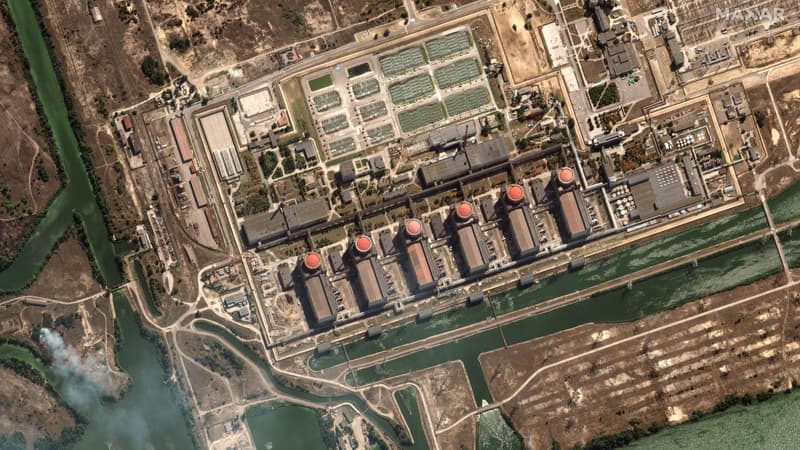The Zaporizhia nuclear power plant was attacked again on Sunday, for which Russia and Ukraine blame each other. If there were no radiation emissions after the bombing, should we worry about the largest nuclear power plant in Europe, while the head of the International Atomic Energy Agency (IAEA), Rafael Grossi, has denounced “targeted” and “deliberate” attacks to BFMTV?
• What are the critical locations?
In the event of strikes in Zaporizhia, as has happened several times in recent months, the plant’s six reactors are the first places to monitor, as are the fuel storage areas, Emmanuelle Galichet, PhD, tells BFMTV.com. nuclear physics.
The plant stores, in particular, uranium 235 and uranium 238, which are used to supply it. Although the chemical elements are kept in “packages” that can protect them in the event of a traffic accident, these packages can still be “cracked by shots”, explains the expert. If touched, these areas carry “radiation hazards.”
Another possible risk is that of a power outage if the wires are touched. In this case, however, there is a backup solution: generators. In Zaporizhia, diesel reserves to power them are available, but only for a maximum of 10 days.
In the event of a prolonged power outage, the reactor’s cooling system could no longer function, posing the risk of a “fuel meltdown accident” and “radioactive emissions into the environment,” according to the French Protection Institute. Radiological and Nuclear Safety (IRSN).
• What are the risks of nuclear materials?
Nuclear material is present at the site in two forms: new and used. In the case of the used nuclear elements, they are located “under concrete domes, so the risk is minimal,” says Ludovic Dupin, information director of the French Nuclear Energy Company (SFEN) on BFMTV.
As for the elements not yet used, they are located in less protected areas. For the head of the SFEN, in this case there is a risk of “localized contamination”, but “no (risk) of explosion”.
• Is there a possibility of a radioactive leak?
The risks of “radioactive emissions” are real, but “they would not enter into the nuclear accident that we experienced in Chernobyl,” Lova Rinel, an associate researcher at the Foundation for Strategic Research, told BFMTV.
Releases are still possible in absolute terms, but they could be done gradually by personnel to “dilute in the atmosphere” so that “the risks are as small as possible,” says Emmanuelle Galichet.
The distance that they could travel is complex to assess because it would depend on elements as variable as wind or rain. Despite this, the expert wants to be reassuring and ensures that in France there is nothing to worry about.
• Could the plant explode?
Currently, all the reactors have been closed since September. “The risk (of explosion) is unlikely”, although not entirely zero, so the doctor in nuclear physics believes, while the “risk of runaway chain” was greater this summer.
Due to the shutdown of the reactors, “atmospheric pressure is at 1 bar, the temperature is below 100°C, therefore far from the melting temperature of the core,” explains Ludovic Dupin, information director, on BFMTV. of the French Nuclear. Energy Company (SFEN).
This makes “a power outage much less likely” and allows on-site staff “more time to find power elsewhere,” says Emmanuelle Galichet.
• Could a Fukushima-like disaster strike?
Since the disaster in Japan in 2011, safety standards have been tightened. The Zaporijia plant is specially equipped with a “containment dome” that did not exist in Fukushima and that could “limit the risks of hydrogen leaks” in the event of a missile launch, says the nuclear physics expert.
In addition, works were carried out at the foundation level of the Ukraine plant in order to confine the molten materials in the plant and ensure that they do not damage the soil. In the event of an external power supply problem, automatic emergency stops are also provided.
For Emmanuelle Galichet, the disaster risks in Zaporizhia remain moderate. Instead, she says she is more concerned about two other Ukrainian power plants, at Khmelnitsky and Rivne in the west of the country, where the reactors are still running. “If the bandits want to do big damage, there are two other plants to target,” she said.
Source: BFM TV


